1.
INTRODUCTION
Lightning flashes are transient discharges of high current that can be
generated in the atmosphere by cumulonimbus clouds, volcanic eruptions, dust
storms, and snowstorms [1].
These electrical discharges can be classified in four categories: intracloud,
intercloud, cloud-to-air and cloud-to-ground (CG) discharges. While an average
of 75% lightning discharges are related with the first three categories (cloud
discharges), the remaining 25% are CG flashes. A typical CG lightning flash is
composed by more than one return stroke discharge (leader/return stroke
sequence). The number of strokes in a flash is referred as the multiplicity.
The return strokes (RS) have a duration of tens of microseconds, and are
typically separated in time from 20 ms to 100 ms [2].
Regarding to the direction in which the charges move and
their polarity, CG lightnings are divided in downward negative lightning, upward negative lightning, downward positive lightning and
upward positive lightning. It is considered that downward negative lightning
flashes represent more than 90% of global CG discharges and that 10% (or less) are downward
positive lightnings [3].
The upward lightning discharges are related with the presence of tall
structures (higher than 100 m) or with objects with moderate height located on
mountains tops. Due to this behavior and its high percentage of occurrence,
this paper focuses on the study and characterization of downward negative CG
flashes.
Several parameters of CG lightnings such as current, electric
charge on clouds and charge transfer, which are used in atmospheric physics and
different lightning studies, can be obtained from the signatures (measurements)
of electromagnetic fields radiated by lightning flashes [3],
[4]. The adequate estimation of lightning parameters and their statistical
information is important for the development and implementation of lightning
discharge models, to design and improve lightning protection systems for
humans, equipment and installations, and to determine the electromagnetic
compatibility requirements for electric and electronic devices, among others.
The electric field signature of a CG lightning flash
sometimes reveals the presence of a pulse train composed by pulses with a
microsecond-scale. This pulse
train is known as the preliminary breakdown (PB) and its features have been
analyzed in different regions of the world [5]–[10].
The PB is produced inside the cloud by a vertical discharge between the
negative charge packet and the lower positive charge packet [4],
[8]. For this reason, PB pulses can provide information about the first event
that produce the electrical breakdown inside the clouds.
Comparative studies about the lightning discharge processes
in different meteorological conditions can contribute to stablish the return
strokes characteristics and provide a better understanding of the lightning
phenomena [4],
[10]–[12]. However, there are only a few measurements done in the tropical
regions (Sri Lanka, Malaysia and Indonesia). For this reason, this paper
presents the results of a research carried out in the Bogotá savanna (central
region of Colombia) based on measurements of the electric field produced by
negative CG lightning flashes. The importance of these results is that Bogotá
is located in the tropical region of the planet but have cold weather and
moderate humidity due to the conditions of the mountainous region where it is
placed (above 2500 meters of altitude). In addition, this is the first study
of its kind that it is conducted in this region of the country.
DATA AND INSTRUMENTATION
The electric field measurements were performed from August
24th to September 14th of 2016 during the beginning of
the second rainy season in Bogotá, Colombia. Bogotá is placed at 2550 m above
sea level in a tropical region near to the equator (between 4.478°N and 4.772°N
latitudes). The region around the city has a cold weather due its location on
the southwestern part of the Altiplano Cundiboyacense (montane savanna) at the
Colombian central mountain range. The measuring station was situated at block
B5 of the Camilo Torres Unit, which is attached to Campus of the Universidad
Nacional de Colombia (4.641° N, 74.091° W).
The measuring system is composed by a 1.5 meters height
parallel flat-plate antenna, which had two circular plates with diameter of
0.45 m with a separation of 0.03 m. The signals from the antenna were fed into a digital oscilloscope Agilent DSO6104A using an
electronic circuit based on the fast buffer BUF602. The function of the buffer,
besides isolating the impedance of the parallel-plate antenna, is to provide
the sufficient power to the measured signal to travel through the long coaxial
cable and reach the recording equipment without significant losses.
A 50 cm long RG-58 coaxial cable was used between the
antenna and the electronic buffer circuit, and another 12 m long RG-58 coaxial
cable was connected between the buffer and the digital oscilloscope. The
oscilloscope operated at a sampling time of 100 ns with a 500 ms full
observation window. In addition, the trigger level was set at 200 mV and a 75
ms pre-trigger was adjusted in order to acquire signals before and after the
trigger transient pulse. The decaying time constant of the buffer was set to
approximately 38 ms. In addition, the time stamp for the signatures
(mm_dd_hh:mm:sss_yy) is obtained using the LAN connection of the oscilloscope
and a personal computer (PC). In this process, the recorded signatures are downloaded
from the oscilloscope to the PC, and its date information is continuously
updated using an internet connection. The summarized scheme of the electric
field measuring system is presented in Figure 1.
|
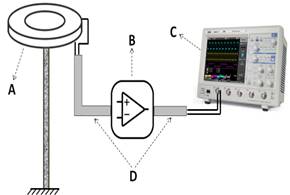
|
|
Figure 1. Electric field system; (A) parallel plate
antenna; (B) electronic circuit; (C) oscilloscope; (D) coaxial cables.
Source: Authors.
|
The electric field sensor was located on the roof of the
building with an approximate height of the 15 meters from the ground level.
Because of this, it was necessary to determine an additional correction factor
due to the influence of the buildings and other structures near to the antenna.
The complete calibration process of the measuring system can be reviewed in [13].
During the installation of the measuring system, the characteristics of the
electromagnetic environment were analyzed using the data collected in [14].
In addition, it was ensured that the grounding system complied with the
requirements established for this type of measurements by applying the
methodology presented in [15].
RESULTS AND DISCUSSION
In order to avoid the horizontal component of the electric
field, the antenna was oriented perpendicular to the vertical electric field
vector or parallel to the ground plane. Using the measuring system described
above, electric field signatures (slow and fast fields) were recorded from
seven (7) thunderstorms obtaining 138 CG lightning flashes. From these records,
the analysis was divided in two sections: lightning flash and the preliminary
breakdown characteristics.
Lightning
flash characterization
The distance of the lightning flashes was estimated with
data provided by the Colombian Lightning Location Network (CLLN) operated by
the company Keraunos, which is a subsidiary of the LINET network [16],
[17]. It is worth clarifying that it was not possible to correlate the
parameters of CG lighting flashes obtained in this study with the parameters of
the flashes measured by CLLN, due to the available information that was
provided.
Table 1 shows the global information of the thunderstorms
analyzed in this work. From 138 CG lightning signatures, 76% of the CG flashes
occurred at distance larger than 50 km from the measuring station. It was also
observed that 127 (92%) flashes had negative polarity, while the remaining 11
(8%) were positive flashes. These percentages are similar to those reported by
several researchers [3],
[18], [19]. In addition, the average number of strokes per flash was 2.4 and
the maximum multiplicity was nine (9) strokes. The flash with the maximum
multiplicity was recorded on September 8th at 19:33:59 as
illustrated in Figure 2.
|
Table 2. Summarized information of the thunderstorms
|
|
Storm
Date
|
Total Flahes
|
% single stroke flashes
|
Maximum multiplicity
|
Average multip
|
|
|
|
24/8/2016
|
21
|
38.1
|
7
|
2.6
|
|
|
29/8/2016
|
13
|
46.2
|
6
|
2.5
|
|
|
30/8/2016
|
6
|
33.3
|
3
|
1.8
|
|
|
3/9/2016
|
15
|
66.7
|
5
|
1.6
|
|
|
8/9/2016
|
12
|
58.3
|
9
|
2.4
|
|
|
13/9/2016
|
39
|
35.9
|
6
|
2.5
|
|
|
14/9/2016
|
32
|
31.3
|
8
|
3.2
|
|
|
|
Source: Authors.
|
With respect to negative CG lightnings, the percentage of
the single-stroke flashes (SSF) was about 38%, which is a high value in
comparison with other tropical and sub-tropical regions such as Sri Lanka (21%)
[20],
Florida (17%) [21],
Malaysia (16%) [22]
and Brazil (17%) [23].
This value can be related with the altitude of Bogotá (mountainous region)
taking into account that a previous study performed in Zhongchuan, China (1900
meters above sea level) reported a percentage of 39.8% in the SSF [5],
very similar to the value obtained in Bogotá .
One of the most important parameters of negative CG
lightnings is the interstroke interval of multiple stroke flashes [10].
Figure 3 shows the interstroke interval of multiple strokes flashes. In this
study, 211 subsequent return strokes (SRS) from 79 negative CG flashes were
analyzed. The obtained results show that the minimum, maximum, arithmetic mean
(AM), geometric mean (GM) of the interstroke intervals were 2.8 ms, 307.5 ms,
61.9 ms, and 47.7 ms, respectively.
|
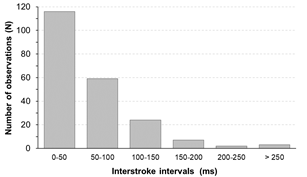
|
|
Figure 3. Histogram of the interstroke intervals for negative
CG lightning flashes (Total observations: 211 intervals). Source: Authors.
|
On the other hand, the flash duration was also analyzed. The
distribution of this temporal parameter is shown in Figure 4. For the 79
negative CG flashes, the minimum and maximum duration were 8.8 ms and 415.2 ms,
respectively. In addition, the AM was 165.1 ms, while the GM was 114.7 ms. It
is important to note that multiplicity and flash duration may depend on the
observation window used during the measurements. In this case, all lightning
flash parameters discussed in this section were obtained using a 425 ms period
(after the first RS).
Preliminary
breakdown characteristics
In order to analyze the parameters of the PB trains, some
definitions about the pulse train, individual pulse duration and interpulse
duration have been adopted from the previous works developed by Nag & Rakov
[24],
[25]. These definitions are follows:
·
Pulse train duration: time interval between the peaks of the
first and last pulses in the train.
·
Individual pulse duration: the full width of the pulse
·
Interpulse duration: the time interval between the peaks of two
consecutive pulses.
From descriptions presented above, PB pulse trains can be
grouped using two definitions (models), the BIL model and BL model. The
"B,I,L" (B: breakdown, I: intermediate, L: leader) description was
defined by Clarence & Malan (1957) and it is used to identify the pattern
of electric field changes (pulse train and the interimpulse durations)
preceding the first negative CG flashes [26].
The BIL model is composed by the following stages [4],
[8]:
|
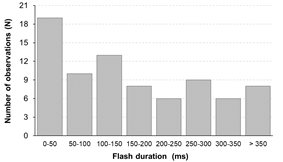
|
|
Figure 4. Histogram of the flash duration for negative CG
lightnings (Total observations: 79 multiple stroke flashes). Source: Authors.
|
·
Initial breakdown (B): lasting some milliseconds, this stage
radiates intense electromagnetic fields and it is followed by an intermediate
stage with little radiation.
·
Intermediate stage (I): lasting up to several hundred
milliseconds, ending with the onset of stepped leaders.
·
Stepped leaders (L): lasting a few milliseconds at the most,
this section produces intensive electromagnetic radiations. This stage finally
ends with the RS.
Figure 5 and Figure 6 show an example of the typical
electric field changes due to the generation of a negative CG lightning flash,
which is initiated by PB pulses with a BIL form (see Figure 6a). For this
signature, two PB trains were observed and seven RS were recorded inside the
observation window (500 ms). In this case, the magnitude of the PB pulse trains
are slightly less than the amplitude of the FRS (see Figure 6b). In addition,
the PB pulses and the FRS have the same polarity. However, this condition is
not the same for all the recorded signatures due to random behavior of the
lightning flashes.
On the other hand, the BL model is related with PB pulses
that might have a duration zero in the intermediate stage (I). An example of
the BL model form is shown in Figure 7 and Figure 8. In this case, it is not
clear the presence of an intermediate stage without electromagnetic radiations.
A close up of the region that covers the PB pulse train and the FRS is
presented in Figure 8a and Figure 8b. Besides, it is possible to observe that
the pulses contained in the train present a random behavior and they have
irregular and complex waveforms. These characteristics are common in the pulses
of the PB stage.
The recorded electric field data have been examined and it
was found that 29 (22.8%) waveforms of 127 negative CG lightning flashes
exhibited PB pulse trains. In this case, the low percentage of the identified
PB pulses was affected by the level of the noise components present in the
measurements (between 3 V/m and 5 V/m) and the observation distance. This
scenario is according with observations reported by Baharudin et al. [8] and Zhu et al. [27]. From 29 negative CG flashes that showed PB
stage, 65.5% (19 signatures) agree with the BIL model, while 24.1% (7
signatures) fit with the BL description. For the remaining 10.4% (3
signatures) the PB stage presented an irregular pattern and they cannot
categorized into either BIL or BL description.
Figure 9 shows the distribution of the duration time for the
29 PB pulse trains that were analyzed. From results, it was possible to observe
that the duration of the PB pulse trains changes from 800 ns to 22 ms. However,
the most of the signatures revealed a PB duration between few miliseconds and
10 ms. Finally, the histogram for the duration of the intermediate zone is
presented in Figure 10. This distribution reveals that most part of 19 records
that agree with the BIL model present an intermediate zone with duration from
few miliseconds up to 60 ms. In this case, the maximum duration was 133.2 ms.
|
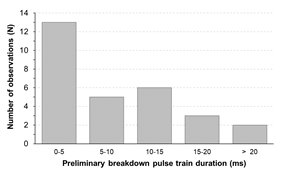
|
|
Figure 9. Distribution of the PB pulse train duration.
Source: Authors.
|
|
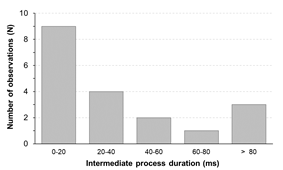
|
|
Figure 10. Distribution of the intermediate time duration.
Source: Authors.
|
CONCLUSIONS
In this paper, the characterization and analysis of negative
CG lightning flash parameters recorded in Bogotá, Colombia was presented. This
study was focused on the analysis of polarity, multiplicity and duration of the
lighting flashes and the main features of the preliminary breakdown pulse
trains.
The results showed that 127 of 138 CG lightning flashes
recorded in Colombia between August and September 2016 exhibited negative
polarity (92%). The average number of strokes per flash was 2.4 and the maximum
multiplicity recorded in an observation window of 500 ms (75 ms pre-trigger)
was 9 strokes. Taking into account this temporal window, some parameters such
as the average multiplicity, the maximum multiplicity, and other temporal
parameters may be limited by the recorded data.
On the other hand, the percentage of single single-stroke
flashes (SSF) was about 38%, which is a high value in comparison with other
tropical and sub-tropical regions such as Sri Lanka, Malaysia, Florida and
Brazil. This value could be related with the altitude of Bogota savanna
(average of 2550 masl). However, it is necessary develop new measurement
seasons in order to validate this hypothesis.
Finally, a statistical analysis on 29 negative CG lightning
waveforms showed that 65.5% of these signatures agreed with the BIL description
(model) of lightning preliminary discharges. From these 29 signatures, 18
signals (62%) presented a PB train duration between 0.8 and 10 ms.
ACKNOWLEDGMENT
Prof. H. E. Rojas express his gratitude to Universidad
Distrital Francisco José de Caldas for its support through the doctoral
commission with contract code N° 0002-2016. In addition, the authors would like
to thank Daniel Aranguren Ph.D., scientific director of Keraunos, for his
collaboration and facilitate the information of the Colombian lightning
location network.
REFERENCES
[1] C.-L. Wooi, Z. Abdul-Malek, N.-A. Ahmad, y A. I. El
Gayar, “Statistical analysis of electric field parameters for negative
lightning in Malaysia”, J. Atmos. Solar-Terrestrial Phys., vol. 146, pp. 69–80,
2016.
[2] K. L. Cummins y M. J. Murphy, “An overview of lightning
locating systems: History, techniques, and data uses, with an in-depth look at
the U.S. NLDN”, IEEE Trans. Electromagn. Compat., vol. 51, no 3, pp. 499–518,
2009.
[3] V. A. Rakov, “Lightning phenomenology and parameters
important for lightning protection”, en IX International Symposium on Lightning
Protection SIPDA, 2007, no Nov, pp. 1–24.
[4] B. Salimi, K. Mehranzamir, y Z. Abdul-Malek,
“Statistical Analysis of Lightning Electric Field Measured Under Equatorial
Region Condition”, Procedia Technol., vol. 11, no Iceei, pp. 525–531, 2013.
[5] X. Qie, Y. Yu, D. Wang, H. Wang, y R. Chu,
“Characteristics of Cloud-to-Ground Lightning in Chinese Inland Plateau.”, J.
Meteorol. Soc. Japan, vol. 80, no 4, pp. 745–754, 2002.
[6] W.-S. Dong, X.-S. Liu, Y.-J. Zhang, C.-X. Chen, y J.-G.
Wang, “Lightning electromagnetic radiation field spectra in the interval from
25 to 100 MHz”, Zhongguo Dianji Gongcheng Xuebao/Proceedings Chinese Soc.
Electr. Eng., vol. 23, no 3, pp. 104–107, 2003.
[7] Z. A. Baharudin, M. Fernando, N. A. Ahmad, J. S. Mäkelä,
M. Rahman, y V. Cooray, “Electric field changes generated by the preliminary
breakdown for the negative cloud-to-ground lightning flashes in Malaysia and
Sweden”, J. Atmos. Solar-Terrestrial Phys., vol. 84–85, pp. 15–24, ago. 2012.
[8] Z. A. Baharudin, N. A. Ahmad, M. Fernando, V. Cooray, y
J. S. Mäkelä, “Comparative study on preliminary breakdown pulse trains observed
in Johor, Malaysia and Florida, USA”, Atmos. Res., vol. 117, pp. 111–121, 2012.
[9] S. N. M. Arshad, M. Izadi, M. Z. A. Ab Kadir, M. A. Abd
Bari, N. Rameli, N. Abdul Rahim, y M. N. Hamzah, “Characterization preliminary
breakdown in the measured lightning electric fields”, 8th Int. Power Eng.
Optim. Conf. PEOCO 2014, no March, pp. 435–438, 2014.
[10] A. Hazmi, P. Emeraldi, M. I. Hamid, y N. Takagi,
“Some characteristics of multiple stroke negative cloud to ground lightning
flashes in Padang”, Int. J. Electr. Eng. Informatics, vol. 8, no 2, pp.
438–450, 2016.
[11] M. A. Haddad, V. A. Rakov, y S. A. Cummer, “New
measurements of lightning electric fields in Florida: Waveform characteristics,
interaction with the ionosphere, and peak current estimates”, J. Geophys. Res.
Atmos., vol. 117, no 10, 2012.
[12] S. N. M. Arshad, M. Z. A. Ab Kadir, M. Izadi, M. N.
Hamzah, C. Gomes, y J. Jasni, “Characterization of measured lightning electric
fields observed in Malaysia”, Int. Conf. Light. Prot. (ICLP 2014), pp.
1058–1063, 2014.
[13] H. E. Rojas, C. A. Rivera, J. Chaves, C. A. Cortés,
F. J. Roman, y M. Fernando, “New Circuit for the Measurement of Lightning
Generated Electric Fields”, en 2017 International Symposium on Lightning
Protection (XIV SIPDA), 2017, pp. 1–7.
[14] C. C. Rodríguez, S. M. Peña, y H. O. Boada, “Estudio
de los niveles de radiación electromagnética no ionizante en varias zonas de la
ciudad de Bucaramanga”, Rev. UIS Ing., vol. 9, no 2, pp. 207–218, Dic, 2010.
[15] Y. P. Goyes Peñafiel, G. Jimenez Diaz, y R. Mier
Umaña, “Aplicación del método de inversión usando mínimos cuadrados (DLS) para
el procesamiento de sondeos eléctricos verticales en Campo Escuela Colorado,
Santander – Caso de estudio”, Rev. UIS Ing., vol. 15, no 2, pp. 125–133, ene.
2016.
[16] C. Tovar, D. Aranguren, J. Lopez, J. Inampues, y H.
Torres, “Lightning risk assessment and thunderstorm warning systems”, en
International Conference on Lightning Protection (ICLP 2014), 2014, pp.
1870–1874.
[17] D. Aranguren, C. Tovar, J. Inampués, J. Lopez, E.
Soto, y H. Torres, “Lightning effects on distribution transformers and
reliability of power distribution systems in Colombia”, Ing. e Investig., vol.
35, no Sup 1, pp. 28–33, 2015.
[18] U. Sonnadara, V. Cooray, y T. Götschl,
“Characteristics of cloud-to-ground lightning flashes over Sweden”, Phys. Scr.,
vol. 74, no 5, pp. 541–548, 2006.
[19] M. A. Uman, The Lightning Discharge. New York, USA:
Courier Dover Publications, 2012.
[20] V. Cooray y K. P. S. C. Jayaratne, “Characteristics
of lightning flashes observed in Sri Lanka in the tropics”, J. Geophys. Res.,
vol. 99, no D10, p. 21051, 1994.
[21] V. A. Rakov, M. A. Uman, y R. Thottappillil, “Review
of lightning properties from electric field and TV observations”, J. Geophys.
Res., vol. 99, no D5, p. 10745, 1994.
[22] Z. A. Baharudin, N. A. Ahmad, J. S. Mäkelä, M.
Fernando, y V. Cooray, “Negative cloud-to-ground lightning flashes in
Malaysia”, J. Atmos. Solar-Terrestrial Phys., vol. 108, pp. 61–67, 2014.
[23] M. G. Ballarotti, C. Medeiros, M. M. F. Saba, W.
Schulz, y O. Pinto, “Frequency distributions of some parameters of negative
downward lightning flashes based on accurate-stroke-count studies”, J. Geophys.
Res. Atmos., vol. 117, no D6, p. n/a-n/a, mar. 2012.
[24] A. Nag y V. A. Rakov, “Pulse trains that are
characteristic of preliminary breakdown in cloud-to-ground lightning but are
not followed by return stroke pulses”, J. Geophys. Res. Atmos., vol. 113, no 1,
pp. 1–12, 2008.
[25] A. Nag y V. A. Rakov, “Electric Field Pulse Trains
Occurring Prior to the First Stroke in Negative Cloud-to-Ground Lightning”,
IEEE Trans. Electromagn. Compat., vol. 51, no 1, pp. 147–150, feb. 2009.
[26] N. D. Clarence y D. J. Malan, “Preliminary discharge
processes in lightning flashes to ground”, Q. J. R. Meteorol. Soc., vol. 83, no
356, pp. 161–172, abr. 1957.
[27] Y. Zhu, V. A. Rakov, S. Mallick, y M. D. Tran,
“Characterization of negative cloud-to-ground lightning in Florida”, J. Atmos.
Solar-Terrestrial Phys., vol. 136, pp. 8–15, 2015